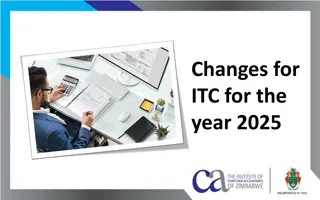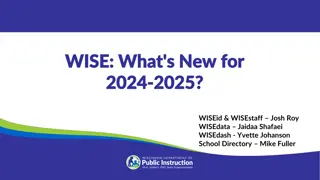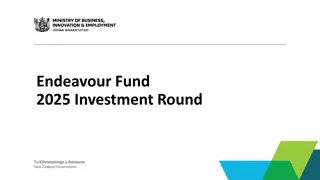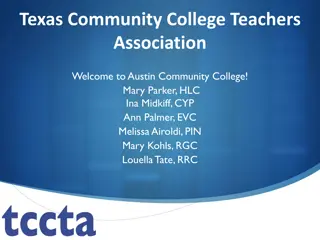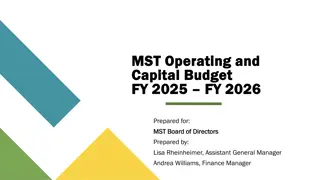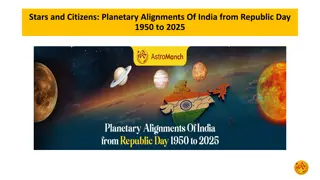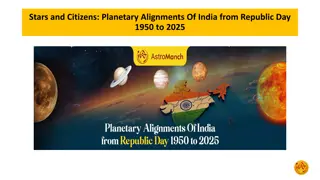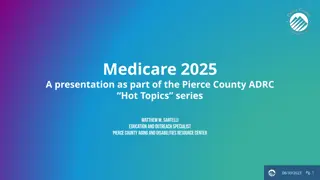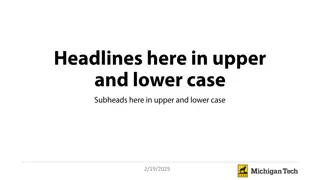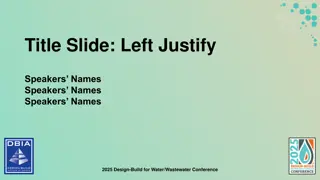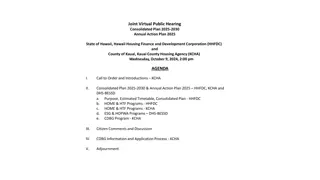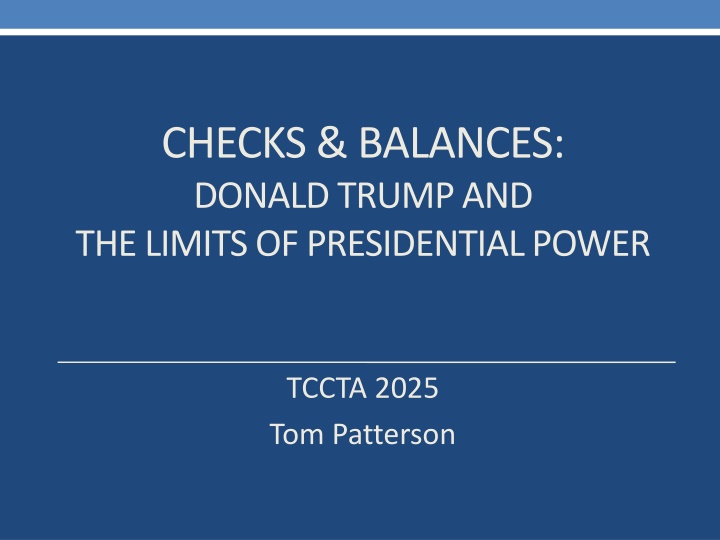
Limits of Presidential Power: Donald Trump & Executive Authority in 2025
Explore the historical context surrounding presidential power, from Franklin D. Roosevelt's New Deal to Donald Trump's aims in 2025. Understand the dynamics between the executive branch, Congress, and the Supreme Court in shaping federal governance.
Download Presentation

Please find below an Image/Link to download the presentation.
The content on the website is provided AS IS for your information and personal use only. It may not be sold, licensed, or shared on other websites without obtaining consent from the author. If you encounter any issues during the download, it is possible that the publisher has removed the file from their server.
You are allowed to download the files provided on this website for personal or commercial use, subject to the condition that they are used lawfully. All files are the property of their respective owners.
The content on the website is provided AS IS for your information and personal use only. It may not be sold, licensed, or shared on other websites without obtaining consent from the author.
E N D
Presentation Transcript
CHECKS & BALANCES: DONALD TRUMP AND THE LIMITS OF PRESIDENTIAL POWER TCCTA 2025 Tom Patterson
Franklin D. Roosevelt in the 1930s the last president who sought to completely redefine federal & executive power During Roosevelt s pre-war presidency: Federal civilian employment nearly doubled from 600,000 in 1932 to 1,100,000 in 1941 69 new federal agencies were created(e.g., Social Security Administration, FDIC, SEC, FCC) Executive Office of the President (EOP) was created (Executive staff increased from 109 in 1932 to 21,428 in 1941).
Roosevelts Political Situation Huge Democratic majorities in Congress 71% of House seats in 1933, rising to 78% in 1937 61% of Senate seats in 1933, rising to 79% in 1937 An obstructionist Supreme Court Repeatedly struck down New Deal legislation (8 acts in its 1935-36 term alone) until 1937 when the stitch in time that saved 9 ended judicial opposition.
Donald Trump in 2025 -aims to completely redefine federal & executive power My administration [will} dismantle government bureaucracy, slash excess regulations, cut wasteful expenditures, and restructure federal agencies.
Donald Trumps Political Situation Narrow Republican majorities in Congress 53-47 in Senate (not filibuster proof) and 218-215 in the House (smallest majority in history) Perhaps a compliant Supreme Court 6 Republican appointed justices, 3 of whom were appointed by Trump during his first term
The Action So Far Congress has been largely on the sidelines except for Senate confirmation of presidential nominees. A host of executive orders counted by suits in federal court (many of them filed by the 22 Democratic State Attorney Generals).
Executive Orders, by President (1981-2024) Average number per year 55 48 46 42 40 36 35 Reagan GHW Bush Clinton GW Bush Obama Trump Biden (1st) Source: Federal Register.
Executive Orders, by President (1981-2025) Average number per year (except Trump2 as of 3/3/2025) 82 55 48 46 42 40 36 35 Source: Federal Register. Number for Trump2 does not include Presidential Memorandum. Most of Trump s orders regarding staff freezes and cutbacks have been in the form of Memorandum,
First-Day-in-Office Executive Orders (1981-2025) Number of executive orders issued on first day as president 26 9 2 1 0 0 0 0 Reagan GHW Clinton GW Bush Obama Trump Biden Trump Bush (1st) (2nd)
Legal Challenges to Trump Administration Directives (as of 2/18) As of 3/3/2025, 96 legal challenges have been filed the figures are the percentage of suits by category Federal workforce 33 Immigration 29 Government funding 22 Individual rights 10 Other 6 Source: Axios and others
Presidential Executive Orders To be lawful, an executive order must derive from a law and cannot violate a law; (theoretically) comply with the President s constitutional duty to "take Care that the Laws be faithfullyexecuted. (The Supreme Court has not ruled on the provision, but it s been said to mean presidential executive action is subordinate to expressly stated congressional directives.)
No final court rulings yet, but likely will result in mixed verdicts Most of President Trump s executive orders are within the law and are not being challenged or stand little chance of being successfully challenged.. Some executive orders appear likely to be struck down, given what federal judges have concluded so far. An example is the Executive Order ending birthright citizenship, which appears to violate the plain meaning rule for judging whether an action is lawful. The 14thAmendment s provision for birthright citizenship: All persons born or naturalized in the United States, and subject to the jurisdiction thereof, are citizens of the United States and of the State wherein they reside.
Status of Political Appointees A president can remove nearly all political appointees at will meaning, without cause. However, some political appointees are by law in a protected category Congress has specified they can only be fired for cause.
Protected Appointees? Those holding for cause positions who ve been fired so far: The Head of DOJ s Office of Special Counsel A member of NLRB Two EEOC members Hampton Dellinger, Head of DOJ s Office of Special Counsel
A Key Case Whats happened so far 1. On Feb 7, President Trump fired Hampton Dellinger, the head of the Office of Special Counsel (oversees whistleblower complaints). Dellinger was appointed by then-President Joe Biden and confirmed by the Senate for a five-year term beginning in 2024. 2. The law creating the position says the holder can only be fired for inefficiency, neglect of duty, or malfeasance in office. Email message dismissing Dellinger gave no reason for removal. 4. A federal district judge issued an order requiring the President to temporarily reinstate Dellinger pending a full hearing. 5. The Trump Administration filed an emergency appeal asking the Supreme Court to block the judge s order, which the Court rejected on grounds the case was still ongoing in lower court. 7. On March 1, a federal district judge ordered the Trump Administration to reinstate Dellinger. Four days later, the DC Circuit Court of Appeals put a hold on the lower-court ruling, allowing Trump to remove Dellinger pending an expedited review of the case.
Precedent on for cause appointees In Humphrey s Executor v. United States (1935), the Supreme Court ruled in a case where President Franklin Roosevelt had fired William Humphrey, a conservative commissioner on the Federal Trade Commission, over policy differences. Humphrey died soon after his dismissal, but his executor sued. The Court ruled in his favor concluding the Constitution does not grant the president illimitable power of removal.
Will the precedent hold? In a 2020 ruling (Seila Law v. Consumer Financial Protection Bureau, the Supreme Court by 5-4 (Roberts and the 4 Democratic appointees in the majority) held that the for cause condition attached to the head of the CFPB violated the separation of powers and that then President Trump had the authority to fire the director. However, the majority said that Humphrey s Executor precedent remained in effect for multi-member agencies like the FTC and FEC. BUT: Court conservatives dissented on the multi-member exception. Since 2020, Ginsburg has been replaced by Coney Barrett, which may create a 5-4 majority that would make all executive appointments at will.
Regulatory Rollback in Trumps First Term Rules and regulations that Trump Administration sought to overturn during first year in office (2017) The point is that the Trump Administration s efforts to downsize the federal government In the months ahead will occur primarily through agency rules. Source: NY Times, 1/20/18
The Administrative Procedures Act of 1946 (note APA applies only to agency rules, not executive orders) Establishes the procedures agencies must follow when changing the rules. The procedures include: Publishing notice of a proposed rule in the Federal Register Allowing for a public comment period on proposed rules & taking those comments into account in finalizing a rule Allowing for a delay between publication of a final rule and its effective date,
Courts Role under Administrative Procedures Act The APA authorizes federal courts to review administrative action for compliance with APA and to set aside agency action deemed unlawful because it is: 1. Arbitrary or capricious 2. Contrary to or in excess of what the law allows 3. Violates the required procedures
Trump Administrations Record under the APA in His First Term Percentage of APA court rulings upholdingthe Administration s actions recent presidents 70 The rulings against the Trump administration usually involved violation of law, failure to follow procedure, and inadequate justification for the action. In most cases, APA suits are decided at the district court level, only rarely by a higher court. Donald Trump 6 Source: Washington Post, first two years of Trump presidency
Agencies now have less discretion than during President Trump s first term In 2024 (Loper Bright Enterprises v. Raimondo), the Supreme Court effectively voided the Chevron doctrine (Chevron v. Natural Resources Defense Council (1984)), which required courts to defer to an agency's reasonable interpretation of ambiguous statutes. Under Loper Bright, courts are now obligated to independently interpret statutory provisions and cannot simply defer to an agency's interpretation.
Going Forward Within the next few months, agency rules are likely to be the main arena of legal action. Reasons: 1. Many of Trump s appointees lack familiarity with their agency and rulemaking and will be in a hurry to change the rules APA procedural violations are predictable. 2. The Biden Administration put in rules designed to make it harder for the Trump administration to change the rules. To overcome that, those rules need first to be negated following a prescribed procedure (for example, a substantial justification for the change and a public comment period). 3. Loper Bright makes it easier for parties to challenge agency rules in courts and, if nothing else, such challenges will slow down their implementation.
27 Trump s Executive Orders on the Undocumented One executive order directs that immigration laws be strictly enforced. A second rescinded an executive order barring ICE agents from entering places of worship, schools, and hospitals for the purpose of detaining the undocumented These orders are lawful. They are in line with federal law and executive authority.
Deportations, by presidential term Number of deportations (in thousands) 4,889 3,178 2,111 2,004 2009-2012 (Obama1) 2013-2016 (Obama2) 2017-2020 (Trump) 2021-2014 (Biden)
The Practical and Legal Challenges Facing the Trump Administration s Deportation Policy The Department of Homeland Security doesn t have the staff or resources to carry out a massive deportation of the undocumented at inland locations (most of the previously deported were removed at or near the border). Accordingly, DHS has: 1. Asked for the help of state and local law enforcement officials; 2. Threatened uncooperative states and localities with loss of federal funding.
DHSs Problem. By law, . . . It cannot command the cooperation of state & local law enforcement officials. In Printz v. United States (1997), the Supreme Court established the "anti-commandeering" doctrine. It holds that the federal government cannot force state and local officials to carry out a federal program. It cannot withhold federal funds from sanctuary states and cities: In San Francisco v. Trump (2018), the Ninth Circuit Court voided a Trump executive order withholding federal funds from sanctuary cities that refused to share immigration status information with federal authorities. The majority noted that no such condition was attached by Congress for eligibility for the funds and that the president has no authority to impose new conditions.
Whats happened so far The Laken Riley Act of 2025) requires the detention and repatriation of illegal aliens who commit, for example, theft, burglary, larceny, shoplifting, and assault. Some states (e.g., Florida) have directed their state & local officials to detain such individuals. Some cities (e.g., San Francisco) have told their officials not to comply. The Trump administration froze federal aid to sanctuary cities. A federal district court judge has placed a temporary hold on the freeze. Likely outcome: Unless the Supreme Court reverses precedent, the Trump Administration will have difficulty achieving its announced goal of deporting millions and millions. 1. 2. 3. 4. 5.
Downsizing the Federal Government
Four Considerations Here 1. Can the president offer deferred buyouts to federal employees? 2. Can the president unilaterally eliminate a federal agency? 3. Can the president reclassify civil servants for the purpose of terminating them? 4. Can the president withhold federal funding to eliminate a program or policy?
Deferred Buyouts On Jan. 28 by email, roughly 2 million federal employees deemed eligible for deferred resignation were offered the chance to resign. By doing so, they would be exempt from all in- person work requirements and would collect salaries and benefits through Sept. 30. Those resigning had to agree to forever waive any action against their agency. They were given under February 6 to resign or lose the opportunity.
Status of the buyout Only hours before the resignation deadline, a federal judge halted the program. The following week, the judge ruled that the plaintiffs (federal workers unions) lacked standing and allowed the program to continue. The buyout appears lawful and likely won t be successfully challenged unless the government fails to provide the promised salary and benefits. (About 75,000 federal employees, 4 percent of the federal workforce, opted for the buyout.)
Elimination of Federal Agencies By law, a federal agency can be eliminated and its employees terminated. But: 1. It requires an act of Congress. 2. Must be conducted according to set procedures, including a "Reduction in Force" (RIF) process that considers factors like tenure, veterans' preference, and performance ratings when deciding which employees are let go. 3. Qualified individuals are eligible for reassignment to other agencies if there are suitable vacancies.
Elon Musk, DOGE, and USAID By law, Elon Musk (or Donald Trump) cannot unilaterally eliminate USAID. But can it effectively dismantle it? Judge Carl Nichols, a 2019 Trump appointee, issued a restraining order halting the Administration s placement of 2,700 USAID employees on administrative leave and directing overseas employees to return to Washington within 30 days or be terminated. Nichols then lifted the restraining order, allowing the Administration s policy to proceed, saying the Administration had made the case that the action was necessary to achieve its policy goals.
What the Administration can do Although the Administration cannot unilaterally abolish USAID, it can reorganize it. (In this case, it can place USAID programs within the State Department. Secretary of State Rubio has assumed the position of USAID s acting director.) Congress role in reorganization differs from its role in an agency s elimination. Congress has to act to block a reorganization whereas congressional inaction blocks the elimination of an agency.
Reclassifying Civil Servants Late in his first term, Trump signed an executive order creating Schedule F as part of the civil service. Such employees could be assigned at will and fired at will. Biden rescinded the executive order upon taking office. A pending court case on the legality of Schedule F was dismissed as moot after Biden rescinded Trump s order.
Bringing Back Schedule F (renamed as Schedule Policy/Career) On the first day of his second term through an Executive Order, Donald Trump reauthorized Schedule F, saying it would cover as many 50,000 federal employees. Is it lawful? Trump Administration position: They argue somehigh- ranking civil servants are in policy-influencing positions and therefore do not meet the neutral non-partisan principle underlying the civil service. Opponents position: These civil servants took positions in the federal government under a contractual agreement that protects them from being treated like political appointees and being denied the protection from arbitrary action afforded by Office of Personnel Management regulations.
Where things stand on Schedule F A lawsuit challenging the creation of Schedule F is pending in a DC federal district court. A pre-emptive act by the Biden Administration that at a minimum will delay the implementation of Schedule F. In 2024, the Office of Personnel Management created a rule that bars career civil servants from being reclassified as political appointees or other at-will workers. Before the Trump Administration could make a change, it would have to go through the process of rescinding the rule action that would be subject to legal challenge.
Federal Funds On Trump s first day in office, the Office of Management and Budget (OMB) issued a freeze on all federal grants and loans. Almost immediately, a federal judge placed a stay on the order. The same day, OMB rescinded the order. However, some funding (e,g, USAID, DEI, Green New Deal) has been slowed or suspended.
The Impoundment Control Act of 1974 The ICA created a process for reviewing the withholding of funds approved by Congress. The act allows a president to withhold funds in specific circumstances (for example, efficiency but not to achieve policy goals) for a limited period (up to 45 days) and requires the president to send a special message to Congress justifying the action. Congress then decides whether to allow spending to be deferred or rescinded. Unless it acts, the funds must be spent.
Is the ICA Constitutional? The Trump administration argues that the law is an unconstitutional intrusion on executive authority claiming the President cannot spend more than Congress appropriates but has the authority to spend less. The Supreme Court has not ruled on the constitutionality of the Impoundment Control Act. However, on March 5 in a 5-4 ruling, the Supreme Court held that the Trump Administration could not withhold payment to foreign aid groups that had met their contractual obligations.
The Trump Administrations position on Executive Power In contesting the ICA and other limits on presidential authority, the Administration has argued that the Supreme Court s 2024 presidential immunity ruling (Trump v. United States) does not simply protect a president from criminal charges when carrying out core constitutional functions. They interpret the ruling as a blanket grant of presidential authority. That is, when the president is operating within the executive s core constitutional functions, its actions are not subject to reversal by the courts of Congress. This interpretation is being argued by the Trump Administration in several of the pending federal court cases and could eventually be decided by the Supreme Court. If the Supreme Court were to accept this interpretation of its 2024 ruling, a president would have unchecked authority for most executive action. It would be a reversal of more than two centuries of legal precedent and fundamentally change the relationship between the presidency and the two other branches of the federal government.
The Known Unknowns in President Trump s efforts to reshape the federal government
Unanswered Questions 1. The current Supreme Court has frequently overturned precedent on major issues (e.g., abortion, affirmative action, presidential immunity) in ways aligned with Republican Party objectives. Will it do so in cases challenging the constitutionality of the Administrative Procedures Act, the Impoundment and Control Act, and Humphrey s Executor precedent? On the other hand,the Court s Loper Bright ruling gives agencies less discretion in rule making. 2. If the issue comes before the Supreme Court, will it accept or reject the Trump Administration s position that it has unchecked authority within the president s core constitutional functions ? 3. Will the Trump Administration in all cases obey Court rulings? (Despite the judicial hold, some funds remain frozen.)

